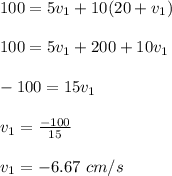
Physics, 18.01.2020 06:31 maribelmartine8919
A5.00 g object moving to the right at 20.0 cm/s makes an elastic head-on collision with a 10.0 g object that is initially at rest.
(a) find the velocity of each object after the collision. cm/s (5.00 g object) cm/s (10.0 g object)
(b) find the fraction of the initial kinetic energy transferred to the 10.0 g object. %

Answers: 3


Other questions on the subject: Physics

Physics, 22.06.2019 05:00, masie03
Red light strikes a metal surface and electrons are ejected. if violet light is now used with a 10% greater intensity, what will happen to the ejection rate (number of ejected electrons per second) and the maximum energy of the electrons? a) greater ejection rate; same maximum energyb) same ejection rate; greater maximum energyc) greater ejection rate; greater maximum energyd) same ejection rate; same maximum energye) none of the above answers are correct
Answers: 1

Physics, 22.06.2019 08:50, dijonmckenzie3
The electronic structure or chlorine is 2.8.7 what is the electronic structure of fluorine?
Answers: 2

Physics, 22.06.2019 12:30, spenceraniyah1
An engine undergoes a cycle as shown in the diagram. during a complete cycle the work done by the gas is 28.5×103 j and the energy transferred thermally out is 99.4×103 j. there are 1.5×1024 gas molecules and they have three active degrees of freedom. 6. (6 pts) during which process(es) is energy transferred thermally into the gas? a. 1→2 b. 2→3 c. 4→1 d. 1→2 and 4→1 e. none of the above
Answers: 3
You know the right answer?
A5.00 g object moving to the right at 20.0 cm/s makes an elastic head-on collision with a 10.0 g obj...
Questions in other subjects:


Mathematics, 03.04.2020 16:46



Mathematics, 03.04.2020 16:46











